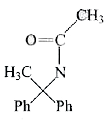Passage-2
Ketoxime when heated with certain reagents undergoes rearrangement to form amides. This is known as Beckmann's rearrangement.

Mechanism:


Find out (X) of the reaction :




The correct Answer is:D
Similar Questions
Out of the given isomeric hydrocarbons which will undergoes rearrangement reaction in acidic medium?
View SolutionWhen an aldehyde with no α- hydrogen react with concentrated aqueous NaOH half the aldehyde is converted to carboxylic acid salt and other half is converted to an alcohol. In other words, half the reaction is oxidized and other half is reduced. This reaction is known as Cannizzaro reaction.

Mechanism:

Find out the products of following reaction:

X and Y are:
View Solution
Knowledge Check
Given is mechanism of Beckmann rearrangement.


Product (A) of the above reaction is :A B
B C
C D
D
When an aldehyde with no α- hydrogen react with concentrated aqueous NaOH half the aldehyde is converted to carboxylic acid salt and other half is converted to an alcohol. In other words, half the reaction is oxidized and other half is reduced. This reaction is known as Cannizzaro reaction.

Mechanism:

Find out X of the reaction:
 A
A B
B CPh−O∣∣C−CH2OHD
CPh−O∣∣C−CH2OHD
Given is mechanism of Beckmann rearrangement.

Which of the following reagent cannot used in Beckmann rearrangement?ATsOHBR−SO2HCBF3DPh−Li
Under common reaction conditions, a carbocation rearranges to another carbocation of equal or greater stability. For example, a secondary carbocation will rearrange to a tertiary carbocation. It will not rearrange to a less stable primary carbocation. This generalization is not absolute, and because there is not a high energy barrier to the rearrangement of carbocations, rearrangement to a less stable cation can occur if it offers the chance to form a more stable product.
In the following cation, H/CH3 that is most likely to migrate to the positively charged carbon is :
H3C1−H∣2C∣OH−⊕3C∣H−H∣4C∣CH3−5CH3
View Solution(Z)-2-Butene reacts with Br2/H2O. The resulting bromohydrin when treated with methoxide in methanol undergoes an intramolecularSN2 reaction. Taking into consideration the stereochemical consequences of the reaction mechanism involved, choose the final product(s) of these transformations.

View SolutionWolff rearrangement
When α-Diazoketones are photo-irradiated or heated at high temperature or reacted with silver oxide or silver salts at room temperature, they loose nitrogen and rearrange to form ketene.
The ketenes reacts rapidly with water, alcohol and amines. Therefore, the reactions called Wolff-rearrangement.

 Major product of the reaction is :
Major product of the reaction is :
View SolutionDi-tert-glycols rearrange in the presence of acid to give alpa-tertiary ketones. The trivial name of the simplest glycol of this type is pinacol, and this type of reaction therefore is named pinacol rearrangement (in this specific case, the reaction is called a pinacol-pinacolone rearrangement). The rearrangement involves 4 steps. one of the hydroxyl groups is protonated in the first step. A molecule of water is eliminated in the second step and a tertiary carbocation is formed. The carbocation rearranges in the third step into a more stable carboxonium ion via a [1,2] rearrangement. In the last step, the carboxonium ion is deprotonated and the product ketone is obtained.

What is R.D.S. of pinacol-pinacolone rearrangement?
View SolutionDi-tert-glycols rearrange in the presence of acid to give alpa-tertiary ketones. The trivial name of the simplest glycol of this type is pinacol, and this type of reaction therefore is named pinacol rearrangement (in this specific case, the reaction is called a pinacol-pinacolone rearrangement). The rearrangement involves 4 steps. one of the hydroxyl groups is protonated in the first step. A molecule of water is eliminated in the second step and a tertiary carbocation is formed. The carbocation rearranges in the third step into a more stable carboxonium ion via a [1,2] rearrangement. In the last step, the carboxonium ion is deprotonated and the product ketone is obtained.


How many products obtained in above reaction?
View Solution

